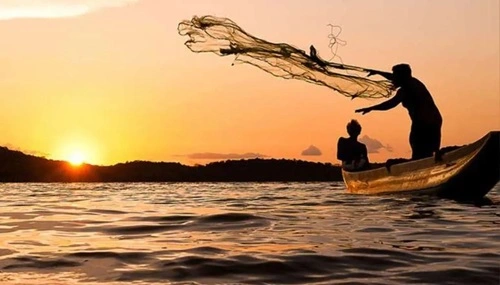Fishing is one of the oldest and most beloved activities in human history. Whether it’s done as a sport, a hobby, or a livelihood, fishing offers a unique connection to nature, promotes relaxation, and provides a fun challenge for anglers of all ages. From the tranquil shores of freshwater lakes to the deep blue seas, fishing is enjoyed by millions across the globe. Here are over ten fascinating facts about fishing that shed light on its history, impact, and many surprises.

1. Fishing Is an Ancient Practice
Fishing dates back tens of thousands of years. The oldest evidence of fishing gear comes from caves in East Timor, where archaeologists have found fish hooks made from shells that are over 42,000 years old. Ancient cultures developed various fishing techniques and gear, from spears and nets to more complex traps and hooks, many of which still influence modern fishing methods.
2. Recreational Fishing Is an Economic Powerhouse
In the United States, recreational fishing contributes billions to the economy each year. According to recent studies, the recreational fishing industry generates over $40 billion annually in economic output, supporting hundreds of thousands of jobs. This impact spans from fishing gear and boat sales to tourism, as anglers travel far and wide to pursue their favorite catches.
3. Bass Fishing: An American Favorite
Bass fishing, especially largemouth bass fishing, is one of the most popular forms of freshwater fishing in the U.S. Bass tournaments draw large crowds, and professional anglers compete for millions in prize money. Largemouth bass are prized for their fighting spirit, making them an exciting challenge for anglers of all skill levels.
4. Catch-and-Release Helps Preserve Fish Populations
Many anglers practice catch-and-release fishing to help conserve fish populations. Catch-and-release involves carefully handling fish and returning them to the water after they’re caught, allowing them to survive and reproduce. This practice helps maintain healthy fish populations in areas where fishing pressure is high, especially for prized species like trout, bass, and muskie.
5. Fly Fishing Is a Technique Rooted in History
Fly fishing, a method that involves using artificial flies to imitate insects and other small creatures, has a rich history dating back to the Roman Empire. Today, fly fishing is practiced worldwide, often in freshwater rivers and streams. Fly fishing has a strong tradition in the United States, particularly in places like Montana and Colorado, where anglers seek trout in beautiful, clear waters.
6. There Are More Than 30,000 Species of Fish
The world’s waters are home to an estimated 30,000 fish species, from tiny minnows to massive whale sharks. This diversity provides endless opportunities for anglers, with freshwater and saltwater species each offering unique challenges. Anglers might catch largemouth bass in a lake, rainbow trout in a river, or red snapper in the ocean, depending on the type of fishing they enjoy.
7. Ice Fishing: A Cold-Weather Adventure
Ice fishing is a winter pastime in colder climates, where anglers drill holes through the ice on frozen lakes and fish through them. Common in the northern United States and Canada, ice fishing has a devoted following. Some anglers brave the cold in temporary shelters or elaborate “ice shanties,” complete with heaters and even televisions, turning the frozen lake into a small community.
8. Fishing Gear Has Evolved Dramatically
Fishing gear has come a long way from simple handmade hooks and lines. Today’s anglers use advanced rods, reels, and lines made from materials like graphite and carbon fiber, designed for strength and sensitivity. Modern fish-finding technology, such as sonar and GPS, has transformed fishing, allowing anglers to locate fish more accurately than ever before.
9. Biggest Fish Ever Caught on Rod and Reel
The largest fish ever caught on rod and reel was a 2,664-pound great white shark caught off the coast of Australia in 1959 by Alfred Dean. This record still stands, showcasing the thrill of deep-sea fishing and the remarkable size some fish can reach. Anglers continue to pursue big-game fish like marlin, tuna, and swordfish, pushing their limits in pursuit of massive catches.
10. Fishing Can Be Good for Mental Health
Fishing has numerous mental health benefits, often described as a meditative activity. It encourages mindfulness, patience, and a connection to nature. Studies show that spending time near water can reduce stress, improve mood, and even lower blood pressure. This is one reason why so many people view fishing as not just a sport but a form of relaxation and escape.
11. Some Fish Can Live Outside Water Temporarily
Believe it or not, certain fish species can survive out of water for short periods. Fish like the mangrove killifish can live on land for several months, adapting to temporary environments without water. Other species, like catfish and mudskippers, can also survive on land by absorbing oxygen through their skin or specialized organs.
12. The Most Expensive Fishing Lure
The world’s most expensive fishing lure is a hand-crafted, diamond-encrusted piece valued at over $1 million. Known as “The Million Dollar Lure,” it’s adorned with 4,753 diamonds and rubies. While no one would dare use it for actual fishing, it stands as a testament to the lengths some anglers will go to celebrate their passion for the sport.
13. Fish Can Detect Vibrations Through Their Lateral Line
Fish have a specialized sensory system called the lateral line, which runs along each side of their body. This line detects vibrations and changes in water pressure, helping fish sense predators, prey, and changes in their surroundings. Anglers often use techniques that mimic these vibrations, like jigging or using certain types of lures, to attract fish.
14. World Record for Most Fish Caught in 24 Hours
The current record for the most fish caught in 24 hours by an individual angler was set in 2010 by Jeff Kolodzinski, who caught 2,649 fish in one day. This feat required endurance and technique, with Kolodzinski focusing on catching small fish quickly and efficiently to reach his goal.
15. Deep-Sea Fishing Reaches Depths of Thousands of Feet
Deep-sea fishing, also known as offshore or big-game fishing, involves fishing miles off the coast in depths of up to several thousand feet. Species like marlin, tuna, and swordfish are common targets. Deep-sea fishing requires heavy-duty gear and boats equipped for the open ocean, where anglers may face challenging conditions in pursuit of prized catches.
16. Many Native American Cultures Developed Unique Fishing Techniques
Fishing was a significant part of life for Native American tribes, who developed various fishing methods tailored to their local environments. Techniques like spearfishing, fish weirs, and netting were used to catch fish efficiently, often combined with sustainable practices that preserved fish populations. Native American fishing methods remain an essential part of cultural heritage and continue to influence modern fishing practices.
17. Fish Have Developed Sophisticated Camouflage Techniques
To evade predators and ambush prey, many fish species have evolved advanced camouflage abilities. Techniques include color-changing, body shape adaptations, and even bioluminescence, where certain fish create their own light. Anglers who understand fish behavior and camouflage strategies have an advantage in catching elusive species by choosing the right time, location, and bait.
18. Some Anglers Compete in Fishing Tournaments Worldwide
Fishing tournaments are held worldwide, covering various types like bass fishing, fly fishing, and deep-sea fishing. These events attract professional anglers who compete for titles, cash prizes, and sponsorships. The Bassmaster Classic, for example, is one of the most prestigious fishing tournaments, held annually in the United States and featuring the country’s best bass anglers.
19. Fishing Supports Conservation Efforts
Many anglers are passionate about conservation, supporting programs to preserve aquatic ecosystems and protect fish populations. Organizations like Trout Unlimited and the Coastal Conservation Association advocate for clean water, sustainable fishing practices, and habitat restoration. By contributing to these efforts, anglers help ensure that future generations can enjoy fishing.
20. Fishing Is a Gateway to Nature and Adventure
For many people, fishing offers a unique gateway to exploring nature, learning about ecosystems, and connecting with wildlife. Whether it’s casting a line from a riverbank, venturing out on a lake, or navigating the open seas, fishing encourages outdoor exploration and respect for the natural world, inspiring a love for the environment.
Conclusion
Fishing is far more than just catching fish; it’s a time-honored activity with deep cultural roots, incredible variety, and numerous benefits. From the thrill of the catch to the relaxation it offers, fishing draws people from all walks of life and all parts of the world. Whether you’re an experienced angler or a curious beginner, these fun facts about fishing highlight the excitement, tradition, and importance of this remarkable pastime.
The next time you head to a lake, river, or ocean, remember these facts and appreciate the rich history and fascinating science behind fishing. It’s a pursuit that goes beyond skill and patience; it’s about building a relationship with nature and carrying on a legacy that has spanned thousands of years.


